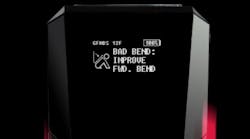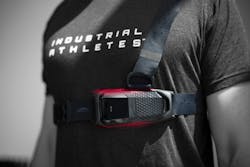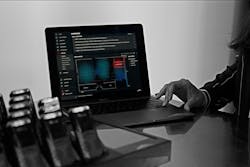How do you get better at a sport without risking injury? The advice is to take it slow; don't do too much too fast. Train, track your progress, listen to your body, and know when to stop.
This advice is really no different for professionals in the material handling field taking on heavy lifting day in and day out. Employees go through training, have best practices, know not to lift too much on their own, know when to ask for help, and know when to stop before they obtain an injury.
Nowadays, most people use smartwatches and fitness trackers to keep track of and improve their health. We have access to tracking steps, calories, sleep, heart rate, exercise, etc. Now the manufacturing industry has a wearable that will help them do the same—but instead of simple tracking, it identifies potential risks in the warehouse to prevent injuries. The FUSE Platform from StrongArm Technologies is a risk monitoring IoT wearable that collects data on environmental and ergonomic factors to help prevent injuries to workers.
New Equipment Digest spoke with Mike Kim, co-founder and CTO of StrongArm Technologies to find out how this risk monitoring device identifies risks and improves employee health over time.
New Equipment Digest (NED): What is the FUSE Platform and what does it do?
Mike Kim (MK): The FUSE Platform is a leading-edge, IoT enabled platform designed to deliver actionable, real-time ergonomic and environmental safety data, all toward the goal of keeping Industrial Athletes™ everywhere proud, protected, and productive.
NED: What sorts of risks does the wearable sensor identify and how does it identify them?
MK: FUSE identifies ergonomic, musculoskeletal injuries from manual material handling risks. It also promotes proximity-based safety and analyzes environmental factors such as temperature, humidity, noise, and general air quality to assess risk, capturing these inputs on the bodies of workers with the FUSE Risk Management Platform. Using proprietary algorithms with real-time edge computing and detailed analytics with our cloud platform, we are able to identify and alert the uses of various risks in the workplace.NED: What data does it provide to the employee? How are employees notified of a risk?
MK: It provides safety performance, trends, ways to improve, and the various different factors. Employees are notified in various ways depending on the severity and nature of the risk. In many cases, we provide real-time alerts on the body to ensure challenges and concerns are addressed as close to the event to help prevent injuries before they happen. In other cases, data is aggregated and post-processed to provide detailed trends, information, and tips to improve over time.NED: How does FUSE learn over time? Does each individual gain a tailored assessment over time?
MK: FUSE doesn’t technically learn on its own over time, but rather it captures safety metrics per aggregated job functions, feedback alerts, and safety metrics to help improve the overall safety performance. We have seen over a 50% reduction in injuries year over year thus far. In the future, we are definitely interested in taking a more personalized approach to providing feedback and training that is tailored to the individual based on their experience.NED: Does the wearable need to be worn with other equipment, such as an exoskeleton? Or can it be used as a standalone product?
The wearable can be worn in conjunction with other equipment, as well as a standalone product. Since our sensor provides alerting capabilities, in addition to capturing safety data, it is great for running experiments and understanding the safety impact in the workplace. Simple questions like, how does this exoskeleton impact safety or how does a change in the rack height of this shelf from 3 ft to 6 ft impact safety are made possible now with our platform and data.
NED: What was the biggest challenge in developing FUSE?
MK: The biggest challenge was distilling for the various stakeholders in the value chain, from the Industrial Athlete to the organizations that employ them and the carriers that insure them, how the data could be most impactful to increase safety in the workplace. When we started nearly 7 years ago now, the industrial wearable technology space was non-existent and there wasn’t really any roadmap that we could compare off of either.NED: Can any workers benefit from FUSE in the industry or is it better suited for warehouse jobs where people are doing a lot of heavy lifting?
Initially, we built the platform to help Industrial Athletes in environments with repetitive, heavy lifting as well as tough environmental factors like temperature, humidity, noise, and air quality. With the COVID-19 pandemic, we’ve been called on to help address a broader set of workers and we have delivered.
NED: FUSE recently added a social distancing and contact tracing feature—can you explain how that works and what it measures?
Today we are leveraging Bluetooth as our primary option for detecting distance between two sensors. It’s specifically measuring RSSI (Received Signal Strength Indicator) between two Bluetooth devices that can be calibrated to a relative distance to one another.
NED: How far is the Bluetooth range? Will it cover an entire facility or can it be customized for certain distances?
The Bluetooth range varies based on the need or functionality. For our system, we have optimized the parameters to be accurate within 6 ft to ensure proper data capture and alerting. In certain scenarios, we are able to make that threshold lower or higher as needed.
NED: Are different sensors needed for the social distancing features or are these capabilities now integrated into the platform?
We like to consider ourselves as the “one-stop-shop.” Every feature is fully integrated into the platform.
NED: What is the starting price point of the platform and how many workers does it cover?
$50/user/month for the full platform, but we've added an option for standalone COVID response that's nearly half the price if you need to ensure business continuity through this tough period.
Mike Kim is the co-founder and CTO of StrongArm Technologies.













